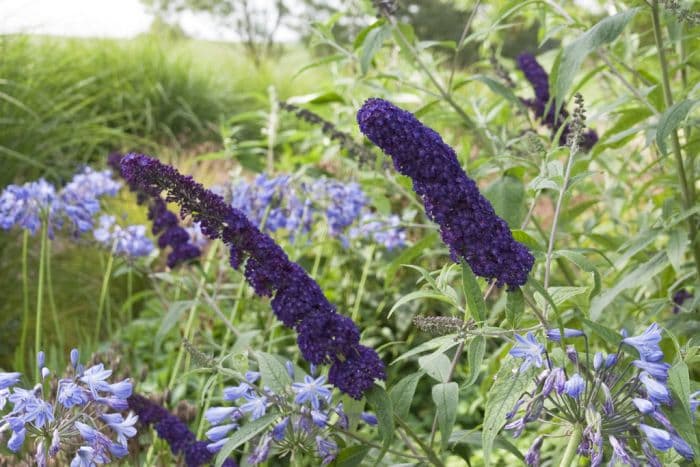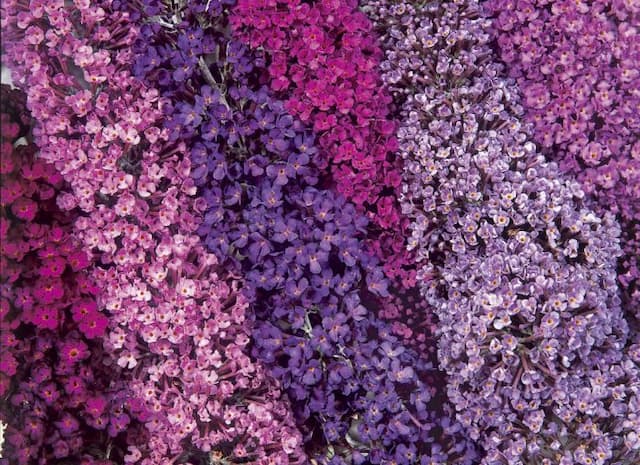Butterfly Bush Buddleja davidii 'Black Knight'

ABOUT
The Buddleja davidii 'Black Knight', also known as the Butterfly Bush, is a striking ornamental plant known for its robust flowering habit. This variety is characterized by the deep purple to almost black color of its cone-shaped flower clusters, which are made up of tiny individual blooms that appear en masse throughout the flowering season. These exquisite blossoms exude a honey-scented fragrance, which is highly attractive to butterflies and other pollinators, earning the plant its common name. The leaves of the Butterfly Bush are another feature, with their lanceolate shape tapering to a pointed tip, exhibiting a willowy elegance. Their color is a muted gray-green, which creates a beautiful contrast with the vibrancy of the flowers. The plant's overall form displays arching branches that lend a casual, yet graceful aspect to its appearance, with foliage that remains dense and lush through the growing season. The textural contrast between the velvety flower clusters and the slightly roughened leaves adds to the visual interest of the Butterfly Bush. Each individual flower comprises four petals forming a tiny tube that beckons to nectar-seeking insects. The blooming period is generous, often stretching from mid-summer into early fall, providing long-lasting color and interest in the garden setting. The stems of the Butterfly Bush have a sturdy quality, which supports the heavy flowering heads and allows them to stand out prominently amongst other garden plants. This striking visual appeal combined with its ease of care makes the Butterfly Bush 'Black Knight' a popular choice among gardeners looking to attract wildlife and create a focal point with a burst of dark, moody blooms.
About this plant
 Names
NamesSynonyms
Black Knight Butterfly Bush, Dark Knight Buddleia, Black Knight Summer Lilac
Common names
Buddleja davidii var. nanhoensis 'Black Knight', Buddleia davidii 'Black Knight'.
 Toxicity
ToxicityTo humans
Butterfly Bush is not considered toxic to humans. There are no well-documented cases of poisoning from ingesting Butterfly Bush, and it is generally considered safe in the landscape with regards to human health. However, like with any plant, individual allergies or sensitivities can occur, so it is always best to avoid ingesting plant material that is not designated as food.
To pets
Butterfly Bush is also not known to be toxic to pets. It does not appear on lists of poisonous plants for dogs, cats, or other domestic animals. While it isn't associated with serious health risks, it's still advisable to prevent pets from consuming plants, including the Butterfly Bush, as they can potentially cause mild gastrointestinal upset or an allergic reaction in some animals. If a pet were to ingest a large amount of any non-food plant, monitoring for any signs of distress and contacting a veterinarian would be prudent.
 Characteristics
CharacteristicsLife cycle
Perennials
Foliage type
Deciduous
Color of leaves
Green
Flower color
Purple
Height
6-8 feet (1.8-2.4 meters)
Spread
4-6 feet (1.2-1.8 meters)
Plant type
Shrub
Hardiness zones
5-9
Native area
China
Benefits
 General Benefits
General Benefits- Attracts wildlife: The plant is known for attracting butterflies, bees, and other beneficial insects, which are essential for pollination.
- Easy to grow: It thrives in a variety of conditions and is relatively low-maintenance, making it suitable for many gardeners.
- Drought-tolerant: Once established, the 'Black Knight' can withstand periods of dry weather, reducing the need for frequent watering.
- Fast-growing: It can quickly fill in spaces within landscapes, providing a lush, full look in a short amount of time.
- Ornamental value: With deep purple to almost black flowers, it provides striking visual interest and can be a focal point in garden designs.
- Tolerant of poor soil: This plant can grow in less fertile soils, which can be advantageous in challenging garden spots.
- Privacy screen: When planted in groups or rows, the Buddleja can create natural, living screens that offer privacy and noise reduction.
 Medical Properties
Medical PropertiesThis plant is not used for medical purposes.
 Air-purifying Qualities
Air-purifying QualitiesThis plant is not specifically known for air purifying qualities.
 Other Uses
Other Uses- Buddleja davidii 'Black Knight', commonly known as Butterfly Bush, can be used in floral arrangements for its deep purple, almost black flowers, providing a striking contrast.
- As a natural dye, the deep purple hues of the Butterfly Bush flowers can be used to color fabrics or yarns.
- The branches of Butterfly Bush can be used to create garden stakes or supports for other plants due to their robustness.
- Fine woodworking projects could potentially utilize the wood of the Butterfly Bush for decorative inlays or as part of small wooden crafts.
- The fragrance of the Butterfly Bush flowers can be captured in potpourris or scented sachets to bring a sweet aroma to drawers and closets.
- Butterfly Bush can be planted alongside roads or highways as a means to reduce noise pollution due to its dense growth habit.
- In photography or painting, the Butterfly Bush can serve as an attractive backdrop or subject due to its vibrant flowers and appeal to butterflies.
- Educational projects on pollination can use the Butterfly Bush as a case study because it attracts a variety of pollinators, including bees and butterflies.
- Butterfly Bush can be incorporated into themed gardens, such as a "moon garden" with plants that have white or silver foliage and flowers that bloom or are visible at night.
- When dried, the seed pods from the Butterfly Bush can be used in arts and crafts for creating natural ornaments or decorations.
Interesting Facts
 Feng Shui
Feng ShuiThe Butterfly Bush is not used in Feng Shui practice.
 Zodiac Sign Compitability
Zodiac Sign CompitabilityThe Butterfly Bush is not used in astrology practice.
 Plant Symbolism
Plant Symbolism- Transformation - Buddleja davidii 'Black Knight', commonly known as the Butterfly Bush, draws butterflies which symbolize transformation and change.
- New Beginnings - The plant's propensity for attracting butterflies, creatures that experience a dramatic metamorphosis, also signifies new beginnings and fresh starts.
- Attraction - Given its ability to attract a variety of pollinators, this plant symbolizes magnetism and the power to attract others.
- Nature Conservation - As a popular choice for wildlife gardens, the Butterfly Bush can represent environmental awareness and the importance of nurturing biodiversity.
- Rebirth - The Butterfly Bush's association with butterflies, whose life cycle is emblematic of rebirth and renewal, lends this meaning to the plant as well.
- Beauty - With its deep purple, almost black flowers, the 'Black Knight' cultivar suggests an appreciation for unconventional or mysterious beauty.
 Water
WaterThe Butterfly Bush, commonly known as Buddleja davidii 'Black Knight', should be watered deeply to encourage deep root development—aim for approximately 1 gallon of water per plant each time you water. During the growing season, water the plant once or twice a week, depending on the weather conditions; more frequently during hot, dry periods and less during rainy spells. Make sure the soil is well-draining to prevent waterlogging. In winter, reduce watering as the plant requires less moisture during its dormant period. Always check the top 2-3 inches of soil for dryness before watering to avoid overwatering.
 Light
LightButterfly Bush thrives in full sun conditions and should be placed in a spot where it can receive at least 6 to 8 hours of direct sunlight each day. A south-facing or west-facing location is usually ideal for these sun-loving plants, ensuring they get ample light to promote robust growth and prolific flowering throughout the season.
 Temperature
TemperatureThe ideal temperature conditions for a Butterfly Bush range from 60 to 85 degrees Fahrenheit. They can survive temperatures as low as 20 degrees Fahrenheit, making them suitable for gardens in colder climates, but they may die back to the ground and regrow in spring. During hot summer months, ensure that the plant is well-watered to cope with the heat.
 Pruning
PruningPrune the Butterfly Bush in late winter or early spring to maintain its shape and encourage more abundant blooms. Remove any dead or damaged branches, and cut back the previous year's growth to about a foot from the ground. This plant blooms on new wood, so annual pruning is important for the best flower production. Deadheading spent flowers during the growing season can also promote further blooming.
 Cleaning
CleaningAs needed
 Soil
SoilButterfly Bush requires well-draining soil enriched with organic matter. A mix of garden soil, peat moss, and perlite or sand can ensure good drainage. The ideal soil pH for Butterfly Bush is between 6.0 and 7.0.
 Repotting
RepottingButterfly Bush typically does not need frequent repotting as it is often planted directly in the ground. Repotting every 2-3 years or when the root system outgrows the container is adequate.
 Humidity & Misting
Humidity & MistingButterfly Bush is tolerant of a wide range of humidity levels and does not require specific humidity conditions for healthy growth.
 Suitable locations
Suitable locationsIndoor
Place in bright light, ensure pot has drainage holes.
Outdoor
Full sun, well-drained soil, prune in early spring.
Hardiness zone
5-9 USDA
 Life cycle
Life cycleButterfly Bush 'Black Knight' (Buddleja davidii 'Black Knight') begins its life cycle as a seed that germinates in spring, usually within well-drained soil and with plenty of sunlight. The seedlings quickly develop into young plants that exhibit rapid growth, and by the first summer, the plant can start to flower, displaying its characteristic deep purple, almost black flowers. After its flowering period in late summer, it sets seeds that can disperse to propagate new plants. Throughout its life, the Butterfly Bush 'Black Knight' undergoes perennial growth, dying back to the ground in colder climates during winter and resprouting from the root system in spring. It requires pruning in late winter or early spring to maintain a bushy form and stimulate the growth of new flowers. The plant has a comparatively short lifespan for a woody shrub, typically living around 5 to 10 years before it may begin to decline in vigor.
 Propogation
PropogationPropogation time
Spring-Early Summer
The most popular method to propagate the Butterfly Bush 'Black Knight' is through semi-hardwood cuttings. This process usually begins in late summer when the current year's growth has begun to mature and harden slightly. A cutting of about 6 to 8 inches (15 to 20 cm) is taken from a healthy branch, making sure a few leaf nodes are included. The lower leaves are removed, and the cut end may be dipped in a rooting hormone to encourage growth before being planted in a well-draining soil mixture. The cutting should be kept in a humid environment with indirect sunlight until roots develop, usually within a few weeks, after which it can be moved to a larger pot or directly into the garden.


![Butterfly bush [Adonis Blue]](/_next/image?url=https%3A%2F%2Fplants-admin.emdemapps.com%2Fimages%2Fplants%2F%2Fimages%2F604b56e58f983.png&w=640&q=75)

![Butterfly bush [Buzz Ivory]](/_next/image?url=https%3A%2F%2Fplants-admin.emdemapps.com%2Fimages%2Fplants%2F%2Fimages%2F604b57987dfa8.png&w=640&q=75)
![Butterfly bush [Camberwell Beauty]](/_next/image?url=https%3A%2F%2Fplants-admin.emdemapps.com%2Fimages%2Fplants%2F%2Fimages%2F604b5ead04c12.png&w=640&q=75)



